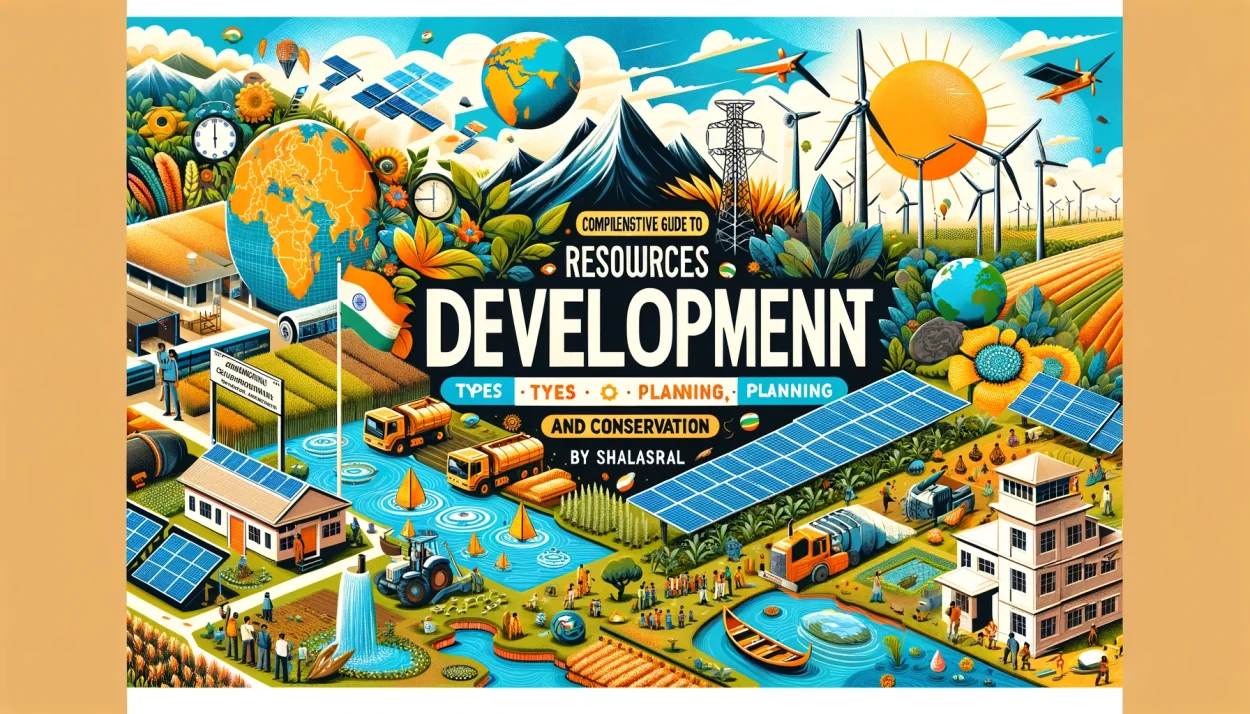
“Comprehensive Guide to Resources and Development in India: Types, Planning, and Conservation”

Introduction to Resources and Development
In the realm of geography, resources are defined as materials found in the environment that humans use to satisfy their needs and wants. These resources, which range from the air we breathe to the soil that grows our food, play a pivotal role in human development. The sustainable management and development of these resources are crucial for our survival and prosperity.
Types of Resources
Resources can be categorized based on their origin, availability, and development status:
- Natural vs. Human-made: Natural resources are those provided by nature without human intervention, like air and water. Human-made resources, on the other hand, are created by humans, such as dams and roads.
- Renewable vs. Non-renewable: Renewable resources can be replenished naturally, like solar energy. Non-renewable resources, such as fossil fuels, have a finite supply and can be exhausted.
- Potential, Developed, and Reserve Resources: Potential resources are those whose utility is not yet known. Developed resources are those that have been surveyed and can be used with current technology. Reserve resources are part of developed resources that can meet future needs.
Development of Resources
Resource development refers to the process of utilizing resources effectively to meet human needs while ensuring sustainability. This involves technological innovation, economic development, and maintaining ecological balance.
Resources Planning in India
Resource planning is a complex process that involves identifying and mapping resources, evaluating their potential, and strategizing for their sustainable utilization. In India, resource planning is crucial due to its vast diversity in geography, culture, and resources. It includes planning at national, state, and local levels with an emphasis on balanced regional development and minimizing environmental impact.
Land Resources and Utilization
Land is a vital natural resource that supports natural vegetation, wildlife, human life, and economic activities. Land utilization refers to the various ways land is used, such as for agriculture, forestry, mining, building houses and roads, and recreation.
Land Use Pattern in India
India’s land use pattern is influenced by physical, socio-economic, and institutional factors. Major categories include forest land, net sown area, fallow lands, and land not available for cultivation. The pattern reflects the economic and cultural practices of the region.
Land Degradation and Conservation Measures
Land degradation, the decline in land quality caused by human activities, is a significant concern in India. It includes soil erosion, deforestation, and pollution. Conservation measures such as afforestation, terracing, and sustainable farming practices are essential to combat land degradation.
Soil as a Resource
Soil, formed through the weathering of rocks and decomposition of organic matter, is a crucial resource for agriculture. Its health determines the productivity of crops and, by extension, food security for the population.
Classification of Soils
India has a diverse range of soil types, classified based on texture, color, moisture content, and chemical properties. Major types include alluvial, black, red, laterite, desert, and mountain soils, each supporting different kinds of vegetation and land use.
Soil Erosion and Conservation
Soil erosion, the removal of the topsoil by water or wind, is a major threat to India’s agricultural productivity. Conservation techniques like contour plowing, crop rotation, and the use of cover crops are employed to protect and preserve soil health.
Conclusion
Understanding the complexities of resources and their development is crucial for sustainable growth and environmental conservation. By integrating resource planning, land and soil management practices, India can ensure the welfare of its present and future generations, balancing economic development with ecological preservation. This comprehensive overview of “Resources and Development” from the “Contemporary India-II” textbook is intended to provide students with a solid foundation in understanding the geographical diversity and resource management strategies crucial for India’s sustainable development.